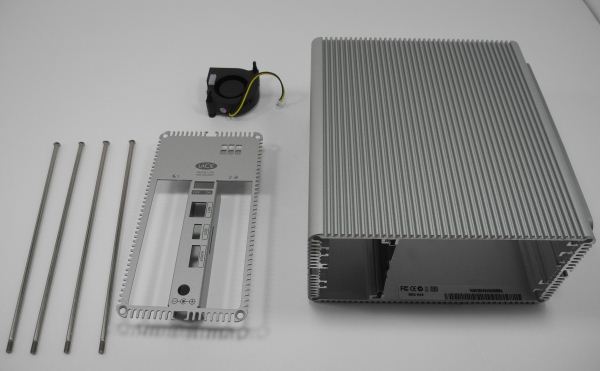LaCie's 2big NAS Review
by Ganesh T S on May 28, 2012 7:55 AM EST- Posted in
- IT Computing
- Storage
- NAS
- LaCie
The LaCie 2big NAS turned out to be one of the easiest NAS units to take apart. There were four screws which were covered up to blend with the gray metal of the chassis, but it was trivial to get them out. After pulling back the rear panel, the front part was slowly eased out. The fan's power connector was carefully removed.
The gallery below shows some of the internal shots of the board.
In the absence of SSH access, we had to determine the configuration of the system from board inspection. LaCie indicates that the NAS is powered by a 2 GHz ARM processor, but provides no other information. As the board shows, it is the Marvell 88F6282 which is at the heart of the NAS. This is a higher clocked version (2 GHz) of the same chip used in the Synology DS211+ as well as the Netgear NV+ v2.
Two Samsung DRAM modules provide a total of 256 MB of DRAM for the system. 512 MB of Hynix flash memory is present on the other side of the board. Other major items on the board include the Marvell Alaska 88E1518 GbE transceiver PHY, a JMB360 PCI-E to SATA II bridge for the eSATA port and an Altera MAX CPLD with unknown functionality.


















15 Comments
View All Comments
DukeRobillard22 - Tuesday, May 29, 2012 - link
The question I always have about a NAS, and which is hard to find out, is "what filesystem does it use?" Like, when its power supply dies, can I pull one of the mirrored disks out, plug it into a SATA port on my Linux box, and get at the data? While it's true the the disks themselves are probably the mostly likely thing to fail, they're not the only thing.Currently, I use an old PC running Fedora with software RAID, just so I can do that when some piece of hardware lets out the magic smoke.
KLC - Tuesday, May 29, 2012 - link
Every time I read an NAS review I'm struck by how expensive they are. More than 2 years ago I bought an Acer Windows Home Server box. It has 4 hot swappable drive bays, an atom processor with 1 gb of memory and Windows Home Server V1. With one 1tb drive it cost me $350 on sale, regular price was $399. Two years later and I see systems with less capability than that one yet they are much more expensive. Why do NAS systems defy Moore's law of more computing capability for less money over time?EddieBoy - Wednesday, May 30, 2012 - link
I keep thinking that I need something to replace my aging Windows Home Server setup. This looks like it might do the trick.But now I am concerned about the Seagate acquisition and whether that might affect their quality and customer support.
Any thoughts on how the acquisition might affect this company?
Thanks.
Zak - Sunday, June 3, 2012 - link
Do these overheat and fry their electronics like most of LaCie enclosures?klassobanieras - Tuesday, June 12, 2012 - link
As the owner of a 4-disk ReadyNAS NV I always felt quite smug about my data until the box itself went bad. This taught me to ask certain awkward questions:- What if the box fails? Do I need to buy another identical box to get my data off my disks or will (e.g.) a Linux machine understand them ok?
- Is it susceptible to the RAID write-hole? Do I need a UPS?
- What kind of data-integrity does it provide, relative to the state-of-the-art (ZFS, btrfs et al)?
Respectfully, I'd suggest that if you're going to seriously test NASes you need to (a) repeatedly yank the power-cord in the middle of metadata-heavy writes, (b) try getting your data off the disks without the use of the NAS itself, (c) see how it deals with a flaky drive and (d) test for data integrity, not just filesystem integrity.
Finally, NASes should be judged in the context of what you can get from an el-cheapo PC running FreeNAS with ZFS, which IMHO puts most consumer NAS boxes to shame.